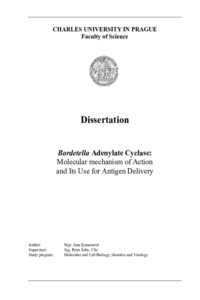Bordetella Adenylate Cyclase: Molecular Mechanism of Action and Its Use for Antigen Delivery
Adenylátcyklázový toxin bakterie Bordetella pertussis: molekulární mechanismus působení a jeho využití jako nosiče antigenů
rigorózní práce (UZNÁNO)

Důvod omezené dostupnosti:
Přílohy práce nebo její části jsou nepřístupné v souladu s čl. 18a odst. 7 Studijního a zkušebního řádu Univerzity Karlovy v Praze ve spojení s čl. 9 opatření rektora č. 6/2010.
Zobrazit/
Trvalý odkaz
http://hdl.handle.net/20.500.11956/31697Identifikátory
SIS: 98082
Katalog UK: 990017062370106986
Kolekce
- Kvalifikační práce [21483]
Autor
Fakulta / součást
Přírodovědecká fakulta
Obor
Genetika, molekulární biologie a virologie
Katedra / ústav / klinika
Katedra genetiky a mikrobiologie
Datum obhajoby
6. 9. 2010
Nakladatel
Univerzita Karlova, Přírodovědecká fakultaJazyk
Angličtina
Známka
Uznáno
Název disertační práce: Adenylátcyklázový toxin bakterie Bordetella pertussis: molekulární mechanismus působení a jeho využití jako nosiče antigenů Autor: Jana Kamanová Souhrn První část této dizertační práce se věnuje molekulárnímu mechanismu působení adenylát-cyklázového toxinu (CyaA). Tento protein z rodiny RTX toxinů je sekretovaný gramnegativní bakterií Bordetella pertussis, která způsobuje infekční onemocnění nazývané černý kašel. CyaA hraje klíčovou roli ve schopnosti tohoto patogena kolonizovat sliznice horních cest dýchacích a to díky schopnosti potlačovat baktericidní funkce myeloidních fagocytujících buněk imunitního systému hostitele. CyaA se váže na integrin CD11b/CD18 (označovaný také jako CR3 nebo αMβ2) těchto buněk, vytváří v jejich buněčných membránách malé kation-selektivní kanály, a dopravuje do jejich cytozolu N-koncovou adenylát- cyklázovou (AC) doménu. Ta je po svém průniku do buněčného cytozolu aktivována navázáním eukaryotického kalmodulinu a katalyzuje velmi efektivní přeměnu ATP na cAMP, jednu z klíčových molekul buněčné signalizace. Tím dochází v napadených buňkách k nárůstu hladiny cAMP, což vyvolá rychlou ztrátu schopností fagocytózy pomocí Fc-receptorů a oxidativního vzplanutí těchto buněk. CyaA má unikátní schopnost přenášet svou AC doménu do cytozolu buněk přímo z...
Dissertation title: Bordetella Adenylate Cyclase: Molecular Mechanism of Action and Its Use for Antigen Delivery Author: Jana Kamanová The first part of this PhD. thesis deals with molecular mechanism of action of the adenylate cyclase toxin (CyaA), a key virulence factor of the whooping cough agent Bordetella pertussis. CyaA belongs to the family of RTX (Repeat-in-ToXin) proteins secreted by Gram-negative bacteria and primarily targets myeloid phagocytes, expressing the CD11b/CD18 integrin receptor (also known as αMβ2, CR3 or Mac-1). Upon binding, CyaA permeabilizes cell membranes by forming small cation-selective pores, and subverts cellular signaling by delivering into host cells an adenylate cyclase (AC) enzyme that converts ATP to cAMP. Elevation of the cytosolic cAMP levels by CyaA then knocks down bactericidal functions of host innate immunity. CyaA is unique among other enzymatically active toxins in its capacity to penetrate cells directly from cell surface across the cytoplasmic membrane, without the need for endocytosis. Penetrating activity of CyaA depends on plasma membrane potential and on an intact, acylated and calcium-loaded RTX cytolysin moiety. By examining a set of 18 CyaA constructs that bear overlapping deletions within AC domain and a CD8+ OVA T-cell epitope tag, we showed that the...
